![]()
![]()
![]()
G Class Submarine: Laid down, as Thrasher, 9 July 1910, at William Cramp & Sons, Philadelphia, PA.; Renamed G-4, 17 November 1911; Launched, 15 August 1912; Commissioned USS G-4, 22 January 1914, at the Philadelphia Navy Yard, Philadelphia, PA.; Decommissioned and struck from the Naval Register, 5 September 1919; Final Disposition, sold for scrapping, 15 April 1920, to Connecticut Iron & Metal Co., New London, CT. The G-4 hulk was assigned hull number SS-26, 17 July 1920.Specifications: Displacement, Surfaced 360 t., Submerged 457 t.; Length 157' 6"; Beam 17' 6"; Draft 10' 11"; Speed, surfaced 14 kts, submerged 9.5 kts; Depth Limit 200'; Complement 1 Officer 23 Enlisted; Armament, four 18" torpedo tubes, eight torpedoes; Propulsion, gasoline electric, Fiat Co, gasoline engines, 1,000 hp, Fuel Capacity 7,650 gals., Diehl Manufacture Co. electric motors, 440 hp, Battery Cells 164, twin propellers.
| Click On Image For Full Size | Size | Image Description | Source | |
|---|---|---|---|---|
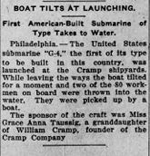 0802633 |
NR | BOAT TILTS AT LAUNCHING. First American-Built Submarine of Type Takes to Water. The United States submarine G-4 (SS-26), the first of its type to be built in this country, was launched at the Cramp shipyards. While leaving the ways the boat tilted for a moment and two of the 80 work men on board were thrown into the water. They were picked up by a boat. The sponsor of the craft was Miss Grace Anna Taussig, a grand daughter of William Cramp, founder of the Cramp Company. |
Image and text provided by Washington State Library; Olympia, WA. Photo from The San Juan Islander. [volume] (Friday Harbor, Wash.) 1898-1914, 23 August 1912, Image 2, via chroniclingamerica.loc.gov. | |
 | 21k | Cramp's Laurenti-designed G-4 (SS-26) unlike contemporary E.B. craft had her ventilators on deck, where access (to prepare for diving) was likely to be difficult in rough weather. Note the droppable safety keel. | Drawing by Jim Christley. Photo & text courtesy of U.S. Submarines Through 1945, An Illustrated Design History by Norman Friedman. Naval Institute Press. | |
 | 41k | G-4 (SS-26) was essentially a submersible surface torpedo boat. For example, her conning tower resembled that of contemporary small steam torpedo boats. The flasks shown above each pair of torpedo tubes (fore & aft) contain firing impulse air. The rods connected the plane control wheels to the planes are shown, as is the safety keel. Note the paired gasoline engines and electric motors on each shaft. This arrangement convinced U.S. submariners that power could be easily increased to achieve greater speed. The device abaft the two motors (abeam the electrical switchboard), is the air compressor, with the main ballast pump abaft it. Crew accommodation is shown forward of the control room and abaft the after vent fan (under the aft ventilator). Batteries are fore & aft of the main ballast tanks. | Drawing by Jim Christley. Text courtesy of U.S. Submarines Through 1945, An Illustrated Design History by Norman Friedman. Naval Institute Press. | |
 | 75k | Cross sections of Laurenti's G-4 (SS-26) at the control room (left) and at the engine room (right) show this boat's characteristic elliptically shaped pressure hull, heavily braced against her outer hull. | Drawing by Norman Friedman & text courtesy of U.S. Submarines Through 1945, An Illustrated Design History by Norman Friedman. Naval Institute Press. | |
 | 2.75k | FIRST SUBMARINE LAUNCHED BY UNITED STATES G-4 (SS-26) launching, at the William Cramp & Sons shipyard, Philadelphia, Pennsylvania, 15 August 1912. | USNHC photograph # NH 73380, collection of William H.F. Michel, donated by Sam Psoras, 1981. Image & text courtesy of Library of Congress, Washington, DC. Photo from the Evening Star. [volume] (Washington, D.C.) 1854-1972, 17 August 1912, Image 19 via chroniclingamerica.loc.gov. |
|
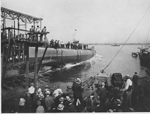 | 95k | Fine screen halftone reproduction of the G-4 (SS-26) launching, at the William Cramp & Sons shipyard, Philadelphia, Pennsylvania, 15 August 1912. | USNHC photograph # NH 103252, from the Collection of the Society of Sponsors of the United States Navy, via Robert Hurst. | |
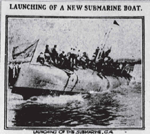 |
NR | LAUNCHING OF A NEW SUBMARINE BOAT | Image and text provided by University of Oregon, Knight Library; Eugene, OR. Photo from Medford Mail Tribune.(Medford, Or.) 1909-1989, 29 August 1912, SECOND EDITION, Image 3, via chroniclingamerica.loc.gov. | |
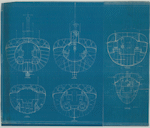 | 872k | Inboard Profile & Interior Plan for G-4 (SS-26), 31 August 1912. | National Archives Identifier: 75841643 Photo courtesy of catalog.archives.gov | |
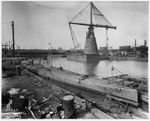 | 1.34k | G-4 (SS-26) fitting out at William Cramp & Sons Shipyard, Philadelphia, PA., 2 October 1912. Note the shipyard crane barge in the background. Laurenti's G-4 was a typical early double-hull design in which the ship-shaped outer hull formed the entire outside of the submarine; there was no flood-able ("self-bailing" in contemporary parlance) superstructure. | US National Archives photo # 19-N-18-7-3, a US Navy Bureau of Ships photo now in the collections of the US National Archives. Partial text courtesy of U.S. Submarines Through 1945, An Illustrated Design History by Norman Friedman. Naval Institute Press. |
|
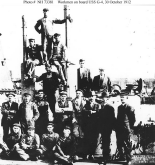 | 101k | Workmen on board the G-4 (SS-26), 30 October 1912, while she was fitting out at the William Cramp & Sons shipyard, Philadelphia, Pennsylvania. The man standing 3rd from left, in the second row, is William H.F. Michel. | USNHC photograph # NH 73381, collection of William H.F. Michel, donated by Sam Psoras, 1981. | |
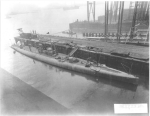 | 311k | G-4 (SS-26) forward broadside view, 2 October 1913. | US National Archives and Record Administration (NARA) photo # 19N18-7-10, courtesy of Daniel Dunham. | |
 | 49k | A mostly submerged G-4 (SS-26) on builder's trials in Delaware Bay, circa 1913-4. | Photo courtesy of the late Ernest C. Schmidt, submitted by Jim McIntire. | |
 | 58k | Starboard side view of the G-4 (SS-26) on builder's trials in Delaware Bay, circa 1913-4. | Photo courtesy of the late Ernest C. Schmidt, submitted by Jim McIntire. | |
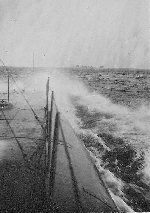 | 57k | Spray off the bow of the G-4 (SS-26) while on builder's trials in Delaware Bay, circa 1913-4. | Photo courtesy of the late Ernest C. Schmidt, submitted by Jim McIntire. | |
 | 52k | G-4 (SS-26) running "awash", while on builder's trials in Delaware Bay, circa 1913-4. | Photo courtesy of the late Ernest C. Schmidt, submitted by Jim McIntire. | |
 | 52k | G-4 (SS-26) in dry dock at Cramp Shipyard in Phila. PA., circa 1913-4. | Photo courtesy of the late Ernest C. Schmidt, submitted by Jim McIntire. | |
 | 82k | Starboard view of the G-4 (SS-26) on builder's trials in Delaware Bay, circa 1913-4. | Photo courtesy of the late Ernest C. Schmidt, submitted by Jim McIntire. | |
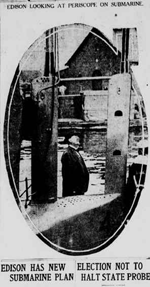 |
1.25k | EDISON LOOKING AT PERISCOPE ON SUBMARINE EDISON HAS NEW SUBMARINE PLAN |
Image and text provided by Library of Congress, Washington, DC. Photo from New-York Tribune.(New York [N.Y.]) 1866-1924, 11 October 1914, Image 1, via chroniclingamerica.loc.gov. | |
 |
406k | NAVAL BATTLES IN EUROPE REMIND US THAT THE UNITED STATES HAS A FLOCK OF SUBMARINES TOO The U.S. was one of the first nations to design and perfect the submarine, but Great Britan & France own many more. This nation is now said to own about 35. The single boat is the G-4 (SS-26), which spends much of its time at the Philadelphia Navy Yard. |
Image and text provided by Penn State University Libraries; University Park, PA. Photo from Evening Public Ledger.(Philadelphia [Pa.]) 1914-1942, 12 December 1914, Night Extra, Image 18, via chroniclingamerica.loc.gov. | |
 |
479k | AN UNDERSEA CRAFT AT REST AT LEAGUE ISLAND This picture of the G-4 (SS-26) of the United States submarine flotilla, was taken just before the submarine left the island yesterday for New York. It will take part there in the great naval review of 17 May. The periscopes may be seen in front of the stern spray shield. A NEAR VIEW OF THE G-4's (SS-26) PERISCOPES The lenses at the very top are the eyes of the submarine. By a system of mirrors everything the lenses catch is reflected to the interior of the submarine. These little detectors are the only parts of the submarine which are exposed when the craft takes a look at the outside world. |
Image provided by: Penn State University Libraries; University Park, PA. Photo from Evening Public Ledger. (Philadelphia [Pa.]) 1914-1942, 12 May 1915, Night Extra, Image 16, via chroniclingamerica.loc.gov. | |
 |
417k | AT THE SUBMARINE MANEUVERS AT NEWPORT, R. I. A United States boat of the G type is nestling close alongside its "mother," the monitor Ozark (M-7). G-1 (SS-19½) arrived at New London, Conn 18 October 1915 in company with three other G-class submarines, tended by monitor Ozark. | Text courtesy of DANFS. Image and text provided by Penn State University Libraries; University Park, PA. Photo from Evening Public Ledger.(Philadelphia [Pa.]) 1914-1942, 07 October 1915, Final, Image 16, via chroniclingamerica.loc.gov. |
|
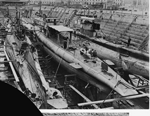 | 1.16k | New York Navy Yard on 24 January 1916, 6 submarines in drydock. G-4 (SS-26) is in the center. Stern planes configuration makes this definitely her. Cool thing - notice the two part hatch on the aft deck. It is a hatch/scuttle combination normally found on surface ships, but EXTREMELY rare on submarines. In fact I would say this is the first time that I have ever seen this on a USN boat. It is probably a feature of her original Italian Laurenti design. The boat on the right is definitely the G-2 (SS-27). G-3 (SS-31) had a similar after superstructure, but by the date of the photo she had already received prominent blister saddle tanks on the side of the hull, and those are missing on this photo. Both boats were known to be in New York during the time of the photo. I'd like to say that the left hand boat is a "K" boat just due to the fact there is some painted Camo in the top of the periscope shears. K-5 (SS-36) or K-6 (SS-37) maybe. The rest of the boats are the other K boats, K-1 (SS-32) & K-2 (SS-33). | Photo & text i.d. courtesy of Ric Hedman & David Johnston. National Archives Identifier: 6881098 Agency-Assigned Identifier: F542N150 Photo courtesy of catalog.archives.gov | |
 | 35k | G-4 (SS-26) photographed prior to World War I, circa 1914-1917. | USNHC photograph # NH 42199, courtesy of Arrigio Barilli, from the Oscar Parkes Collection. | |
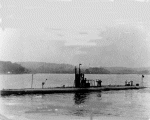 | 59k | G-4 (SS-26), possibly at New London, CT., 1916. | USN photo. | |
 | 61k | Halftone reproduction of a photograph of the G-4 (SS-26) underway prior to World War I, circa 1914-1917. Copied from the book United States Navy Illustrated, published in New York, 1917. | USNHC photograph # NH 79487 | |
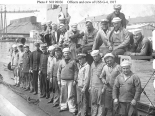 | 128k | G-4 (SS-26) officers and crew posed on deck, 1917. She was then operating out of the U.S. Naval Submarine Base, New London, at Groton, Connecticut. The two officers (4th & 5th from left, front row) are Lieutenant (Junior Grade) Paul F. Foster (Commanding Officer) and Lieutenant (Junior Grade) William F. Callaway (Executive Officer). | USNHC photograph # NH 98036, collection of Vice Admiral Paul F. Foster. | |
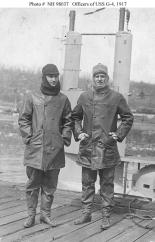 | 85k | G-4 (SS-26) officers standing beside their submarine, at the U.S. Naval Submarine Base, New London, Groton, Connecticut, in 1917. They are Lieutenant (Junior Grade) William F. Callaway (Executive Officer), at left, and Lieutenant (Junior Grade) Paul F. Foster (Commanding Officer). Note their leather coats and cold weather helmets. G-4's periscopes are behind the men. | USNHC photograph # NH 98037, collection of Vice Admiral Paul F. Foster. | |
 |
NR | THE UNITED STATES G-4 (SS-26) HIGH AND DRY FOR INSPECTION. It is not often that one can get such a view as this of the superstructure of the "terror of the seas". At the stern are two of the tubes from which the deadly torpedoes are launched. |
Image and text provided by Penn State University Libraries; University Park, PA. Photo from Evening Public Ledger. (Philadelphia [Pa.]) 1914-1942, 14 February 1917, Night Extra, Image 18, via chroniclingamerica.loc.gov. | |
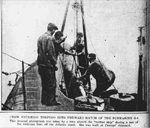 |
NR | CREW ENTERING TORPEDO INTO FORWARD HATCH OF THE SUBMARINE G-4 (SS-26) This unusual photograph was taken by a man aboard the "mother ship" during a test of the undersea boat off the Atlantic coast. |
Image and text provided by Penn State University Libraries; University Park, PA. Photo from Evening Public Ledger. (Philadelphia [Pa.]) 1914-1942, 14 February 1917, Night Extra, Image 18, via chroniclingamerica.loc.gov. | |
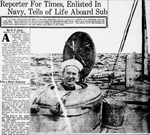 |
1.35k | Reporter For Times, Enlisted In Navy, Tells of Life Aboard Sub G-4 (SS-26) |
Image and text provided by Washington State Library; Olympia, WA. Photo from The Tacoma Times.(Tacoma, Wash.) 1903-1949, 24 May 1917, Image 1, via chroniclingamerica.loc.gov. | |
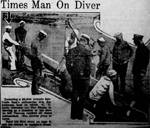 |
NR | Times Man On Diver | Image and text provided by Washington State Library; Olympia, WA. Photo from The Tacoma Times.(Tacoma, Wash.) 1903-1949, 25 May 1917, Image 7, via chroniclingamerica.loc.gov. | |
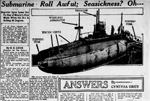 |
NR | Submarine Roll Awful: Seasickness? Oh-- Reporter Lyon Loses Out On One of Shorty's Fine Meals When the G-4 (SS-26) Is Rolling 38 Degrees. |
Image and text provided by Washington State Library; Olympia, WA. Photo from The Tacoma Times.(Tacoma, Wash.) 1903-1949, 28 May 1917, Image 4, via chroniclingamerica.loc.gov. | |
 |
398k | G-4 (SS-26) at sea. | Photo by Arkivi/Getty Image, courtesy of gettyimages.com. | |
 | 79k | G-4 (SS-26) tied up alongside a dock, presumably at the New London Submarine Base, Groton, Connecticut, circa 1918. G-4 (SS-26) is inboard of G-2 (SS-27). | USNHC photograph # NH 80585. Courtesy of the Naval Historical Foundation, collection of Lieutenant O.E. Wightman. | |
 | 107k | G-4 (SS-26) at the New London Submarine Base, Groton, Connecticut, about February 1918. The "boats" are (from left to right): G-4 (SS-26); G-2 (SS-27); and L-8 (SS-48). | USNHC photograph # NH 80743. Courtesy of the Naval Historical Foundation, collection of Lieutenant O.E. Wightman. | |
 | 127k | G-4 (SS-26) at Sub Base Groton, CT., circa 1917-18. | Ric Hedman TN(SS) Webmaster PigBoats.COM TM, a Historic Look at Submarines |
|
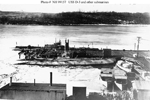 | 380k | D-3 (SS-19) alongside a dock with other submarines on an icy day, circa 1918. Location is probably the Submarine Base at Groton, Connecticut. D-3 appears to be wearing pattern camouflage. Other submarines present are (moving outward from D-3: D-1 (SS-17); G-4 (SS-26); and G-3 (SS-31). | Photograph # NH 99157 via Robert Hurst. | |
View the Thresher / G-4 (SS-26)
DANFS history entry located on the Haze Gray & Underway Web Site.
Crew Contact And Reunion Information
Not Applicable to this Vessel
Additional Resources and Web Sites of Interest
PigBoats.COM TM, a Historic Look at Submarines
| Back To The Main Photo Index | Back To the Submarine Index |
| Problems and site related matters, E-mail Webmaster |
| This page is created by Gary Priolo and maintained by Michael Mohl All Pages © 1996 - 2025 NavSource History |